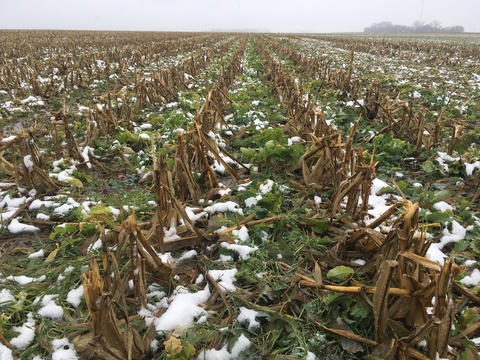Cover crops
Cover crops are grown outside of the cash crop growing season, usually seeded in the fall and killed before spring planting.
Keeping living roots in the ground year-round can improve water management, soil protection and nutrient scavenging, but they need to be given the same attention as a cash crop to ensure success.
Try cover crops on a small scale first, and look into cost-share from state and local governments.
Some of the best opportunities are with early-harvested cash crops like corn silage, small grains, and canning crops like beans and peas, as you’ll get more vigorous fall growth if you plant in late summer and early fall.
In fields where wheat was just harvested, simply allowing it to reseed itself without tilling the land would work as a cover crop. But cover crops can work with standard corn-soybean rotations as well.
Benefits of cover crops
Erosion control
Cover crops reduce erosion in a few different ways.
- Aboveground, living cover crops protect the soil from rainfall impact and reduce the effect of wind. Runoff is reduced along the way.
- Belowground, roots hold soil in place during active erosion events and build structure. Better soil structure means the soil is less likely to erode even if left bare later in the season, such as between harvest and cover crop planting.
- Runoff sediment also contains soil phosphorus, so reducing runoff is an important strategy for reducing P loading in surface water.
Infiltration and water management
Cover crop root systems create large channels through the soil to allow increased infiltration. This effect is especially significant for species with large taproots, but other cover crops also increase infiltration.
- Increased infiltration means fields are less likely to stay saturated during Minnesota’s rainy springs.
- Many farmers report dry field conditions more quickly after a rain event when they use cover crops.
Cover crops can also help soil store water by building soil structure and creating a network of large and small pores.
- Once water enters the soil through infiltration, this pore network retains water for plants to take up as necessary.
- This increase in soil water holding capacity can be especially beneficial in dry years.
Nitrate reduction
Soil nitrate reduction is well-established in Minnesota for a variety of cover crops.
- Nitrate is often left in the soil after fall harvest of corn.
- A winter cover crop takes up soil nitrogen, so less nitrogen is leached. This is an important benefit for reducing groundwater nitrate contamination.
- Farmers should expect some nitrate drawdown by cover crops and plan the subsequent season’s fertility accordingly.
- Soil testing before applying N to cash crops can help with field-specific recommendations.
Minnesota cover crop recipes
For a quick way to get started, Minnesota cover crop recipes provide step-by-step guidance to some of the lowest-risk starting points for cover crops. These recipes don’t cover all possibilities, but they can help beginners incorporate cover crops into a farm operation.
- Post corn, going into soybean: Use cereal rye
- Post soybean, going to corn: Use oats
- Post corn silage, going to corn: Use cereal rye
- Post corn silage, going to soybean: Use cereal rye
Learn more about reducing tillage and incorporating cover crops:
Getting started with cover crops
- Benefits of cover crops.
- Choosing a cover crop (consider crop rotation, harvest timing, overwintering, etc.).
- Recommended planting dates and seeding rates for cover crops.
- Comparison of cover crop benefits by crop.
Planting green in Minnesota
- Benefits of biomass production
- How termination date affects biomass production
Planting date matters for cover crops, too
- Timing of fall seeding
- Termination timing on biomass production
Reduce risk of fallow or flooded soil syndrome with cover crops
- How and when fallow syndrome occurs.
- How it affects crops.
- How cover crops can help.
- How to manage fallow syndrome.
New cover cropping opportunities in Minnesota
- Research summary: Interseeding cover crops into V7 corn using several species and planting techniques.
Early season cover crop interseeding in corn
- Potential for interseeding cover crops into corn.
- Managing cover crops to reduce competition with corn.
- Optimum seeding time.
- Interseeding strategies.
Using herbicides and cover crops in corn and soybean
- Residual herbicides can impact cover crop establishment and growth.
- Considerations for grazing or harvesting cover crops for forage.
- Cover crop sensitivity to herbicide carryover.
Herbicide persistence and carryover to cover crops
- How to manage carryover risk to cover crops
- Cover crop rotations, commonly used herbicides and potential injury
- Sensitivity of different cover crops
Spring management of cover crops
- Guidance on mechanical and chemical termination, including carbon-to-nitrogen ratios of common crops.
- Factors affecting residue.
- Pest management tips.
- How to time spring termination for cash crop planting.
In this Strategic Farming webinar, researchers Monica Schauer, UW-Madison, and Anna Cates, UMN Extension educator, discuss fertility and crop rotation with cover crops.


